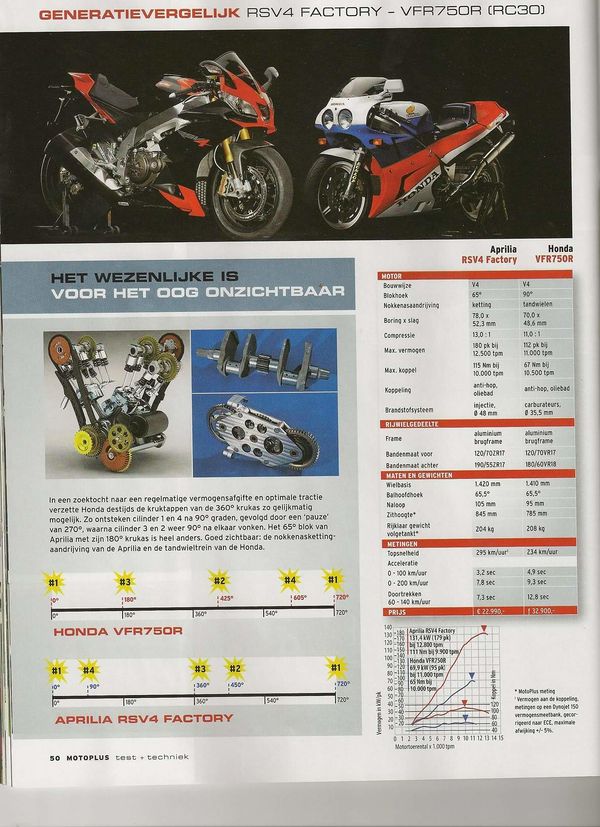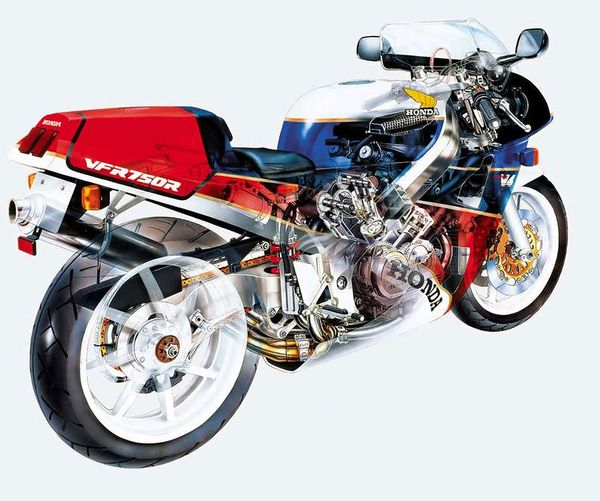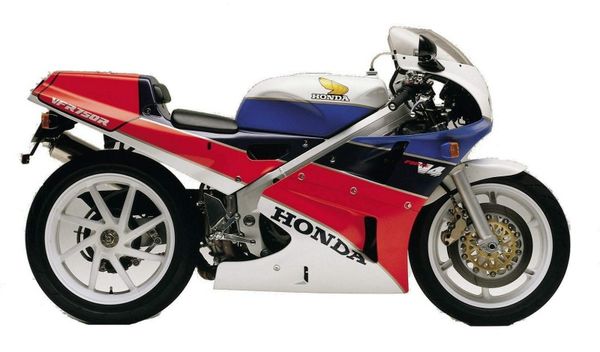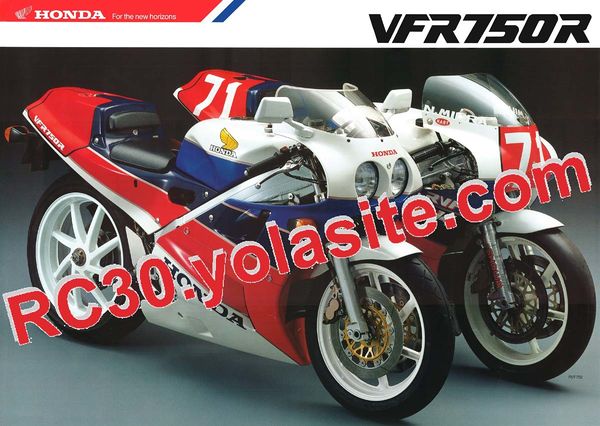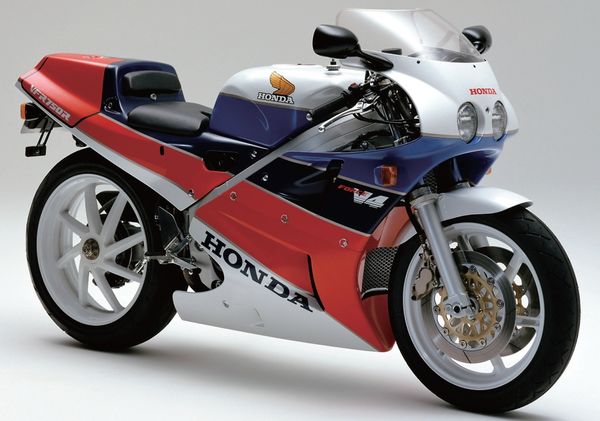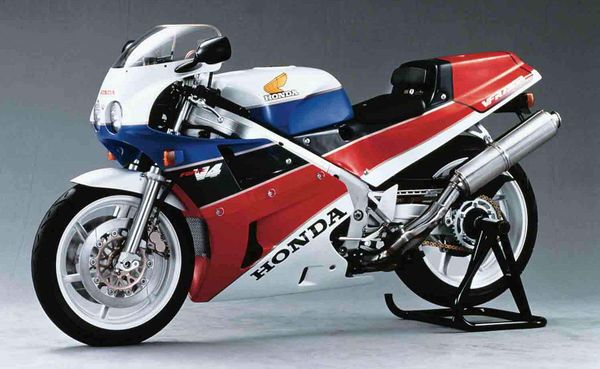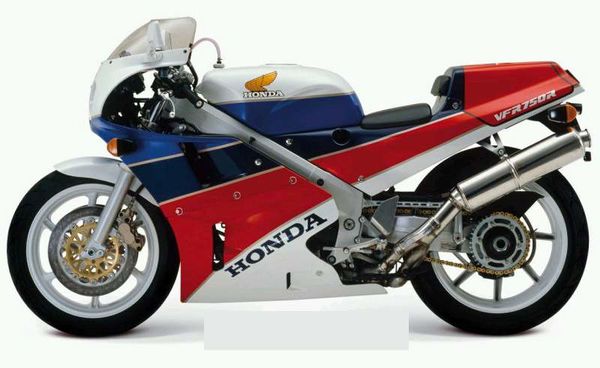Honda VFR750R RC 30
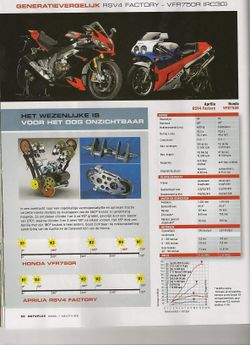 |
|
| Honda VFR750R RC 30 | |
| Manufacturer | |
|---|---|
| Production | 1987 |
| Class | Power Cruiser |
| Engine | Four stroke, 90°V-four cylinder, DOHC, 4 valve per cylinder |
| Compression ratio | 11.0:1 |
| Top Speed | 244.3 km/h / 151.8 mph |
| Ignition | CDI |
| Spark Plug | NGK CR9EHIX-9 (For a modern Iridium tip) |
| Transmission | 6 Speed |
| Frame | Backbone Type - Diamond layout with 3 section extrusions and cast headstock, engine lugs and rear section. Tig welded. |
| Suspension | Front: 43mm Telescopic USR fork Adjustable compression & rebound damping, single nut quick change front wheel clamps Rear: Pro-Arm progressive rate, single sided/single nut wheel, inboard brake, Pro Squat linkage, adjustable for preload and compression & rebound damping |
| Brakes | Front: 2 x 310mm discs, 2 piston calipers Rear: Single 220mm disc, 2 piston caliper |
| Front Tire | 120/70 V17 |
| Rear Tire | 170/60 V18 |
| Wheelbase | 1410 mm / 55.5 in |
| Seat Height | 785 mm / 30.9 in |
| Weight | 185 kg / 402 lbs (dry), 206 kg / 450 lbs (wet) |
| Recommended Oil | Honda GN4 10W-40 |
| Fuel Capacity | 20 Liters / 5.3 US gal |
| Manuals | Service Manual |
It could reach a top speed of 244.3 km/h / 151.8 mph.
Engine[edit | edit source]
The engine was a Liquid cooled cooled Four stroke, 90°V-four cylinder, DOHC, 4 valve per cylinder. The engine featured a 11.0:1 compression ratio.
Drive[edit | edit source]
Power was moderated via the Wet multiplate, sprag slipper on outer plates..
Chassis[edit | edit source]
It came with a 120/70 V17 front tire and a 170/60 V18 rear tire. Stopping was achieved via 2 x 310mm discs, 2 piston calipers in the front and a Single 220mm disc, 2 piston caliper in the rear. The front suspension was a 43mm Telescopic USR fork Adjustable compression & rebound damping, single nut quick change front wheel clamps while the rear was equipped with a Pro-Arm progressive rate, single sided/single nut wheel, inboard brake, Pro Squat linkage, adjustable for preload and compression & rebound damping. The VFR750R RC 30 was fitted with a 20 Liters / 5.3 US gal fuel tank. The bike weighed just 185 kg / 402 lbs. The wheelbase was 1410 mm / 55.5 in long.
Photos[edit | edit source]
Overview[edit | edit source]
Honda VFR 750R RC30
Honda RC30 marked a huge leap forward in Japanese motorcycle design. It was the first Japanese bike to rival the beauty and build quality previously the domain of exotic specialists like Bimota. When it hit the market in 1988 the press were in danger of running out of superlatives. And dealers soon ran out of bikes to sell to the well-heeled enthusiasts who queued up to spend twice the price of a Suzuki GSX-R on the most talked-about bike for years. And the talk was certainly no exaggeration. The RC30 combined the light weight, quick steering and fantastic rider feedback of a race bike with excellent ride quality, reliability and perfectly stable behavior on even the most indifferent road surface.
The RC30 - also called the VFR750R, but
everyone referred to it by its factory code name - was based on the
all-conquering full-factory RVF750 Endurance and Fl bike. When Fl gave way
to World Superbikes, one-off bikes like the RVF were no longer eligible, so
the RC was designed from the start as a limited edition road bike, intended
to sell just enough to qualify for World Superbikes. Crucial parts - such as
chassis, engine casings and carbs - can't be changed under WSB rules, so
they needed to be ready to race. In other areas, Honda were free to
concentrate on making the RC30 reliable and user-friendly for the road,
knowing that those parts could be changed for racing if necessary.
The RC's V-four is a superb road engine. It's smooth,
extremely powerful and very reliable. It's also instantly recognisable - you
can't mistake the sound or feel of a Honda V-four, whether you're sitting on
a standard RC30 blipping the throttle, or sitting by the side of the TT
course listening to a tuned example on full throttle. The RC has a rich
droning exhaust note that never really sounds as though it's working hard.
On die road, it probably isn't - even first gear on the RC's close-ratio box
is enough to take you to 80mph, so full load in top gear isn't something the
RC has to put up with very often.
On the track of course, hard work is what it's all about. A full factory race kit was available from the start - containing everything from modified pistons to new camshafts and crankshafts - as well as kits from the many independent tuners who brought their skills to bear on its complex V-four engine. And the RC30 was born to race. It raised the stakes in the fledgling World Superbike Championships, dominated the demanding Isle of Man TT course and became the bike to have if you wanted to get anywhere in World Endurance. It would be a long time before the other manufacturers caught up. Visually, the RC shouts its race credentials with its single seat, its smooth, uncompromising lines and its single-sided swing arm at the rear.
The latter was designed, like the quick-change mechanisms on die front forks, to waste the minimum time on pit stops in 24-hour endurance races. For the road it has no real function except to look good - and it certainly docs that! Hidden away above it, though, is one of the most perfectly set-up suspension systems ever fitted to a road bike. It tracks over bumps as though they don't exist, and it would take a racetrack to make it misbehave. The forks, too, are well set-up they may not be fashionable inverted types, but it's the quality that counts. It's a testimony to the excellence of its design that even now, eight years after its launch, the RC30 is still capable of top ten finishes at the TT, and it's still a stunning bike to ride on the road.
Source Super Bikes by Mac McDiarmid
Battle of the V4s: Honda VFR750R RC30 vs Aprilia RSV4 Factory APRC What can we say about the Honda RC30 that hasnt already been said before. Yes, were among the vast number of fans which the 750cc V4-engined VFR750R still has more than two decades after it was launched. A mere 3,000 units of this bike were produced between 1987-1990 and even back then, it cost a massive US$15,000. The RC30s claimed dry weight was 185 kilos and according to some magazine road tests of the era, the bike weighed as much as 215kg with all fluids and a full tank of fuel. And by modern standards, the 750cc V4s power output was rather ordinary 112bhp at 12,000rpm, which went up to a more respectable 133bhp with the HRC race kit that was available from Honda.
If the RC30 wasnt all that powerful and was a bit heavy, whats the fuss all about? More than 20 years on, why is the world still so taken with the VFR750R? Perhaps there is no logical answer to this question. Maybe its the image we have in our minds, of watching men like Joey Dunlop and Steve Hislop and Carl Fogarty racing the RC30 around the Isle of Man. Maybe its the bikes sheer beauty, its racy stance, its single-minded racing focus and the fact that it was designed by HRC that makes it so attractive. Or perhaps its the bits inside that Honda V4 titanium conrods, 360-degree one-piece crank, gear driven camshafts that make the bike exotic and desirable.
Based on Hondas RVF750 world endurance and TTF1 racebikes, the VFR750R RC30 was
essentially a homologation special, built to satisfy the requirements of the
World Superbikes series which started in 1988. The first batch of 1,000 bikes
was released in Japan in 1987 and sold out quickly, despite a price tag of 1.5
million Yen. The RC30 came to Europe in 1988 and to the US in 1990, by which
time it had already won the first two WSBK titles Fred Merkel won the 1988 and
1989 World Superbikes championships aboard the VFR750R. Apart from WSBK, the
RC30 was also very successful at the Isle of Man TT races in the hands of riders
like Steve Hislop, Joey Dunlop and Carl Fogarty.
Moving the story two decades forward, things are a bit more bleak for Honda today. After Fred Merkels two championship wins in WSBK with the RC30, Honda have only won four titles in World Superbikes 1997 (John Kocinski, with the RC45), 2000 and 2002 (Colin Edwards, with the RVT1000R RC51), and 2007 (James Toseland, with the CBR1000RR Fireblade). Technological innovations seems to have taken a backseat at Honda, even as European manufacturers like Aprilia, BMW and Ducati have surged forward with some truly stupendous machines. And in 2012, Hondas top-of-the-line V4-engined motorcycle is a porky sports-tourer rather a lean, mean, cutting-edge sportsbike. Sure, the current Fireblade is a thoroughly competent machine, but its nowhere near as exciting as, say, a BMW S1000RR, Kawasaki ZX-10R Ninja, Ducati 1199S Panigale or Aprilia RSV4 Factory APRC.
Speaking of the Aprilia, their V4-engined RSV4 Factory APRC which won the 2011 WSBK championship in the hands of Max Biaggi today occupies the spot which the RC30 held almost 25 years ago. Its sharp, edgy, exciting, high-tech and properly exotic, all of which the RC30 was back then. So, the next thing youd think about is, how would the two bikes iconic machines belonging to two different generations stack up against each other? Surely, in terms of outright performance and handling, the 25-year-old RC30 cant possibly stand a chance against the RSV4, which has a bigger, vastly more powerful engine and a full complement of modern-day electronics, including traction control?
A while ago, Dutch magazine MotoPlus actually managed to do this shootout where they compared the RC30 with the RSV4. Here are some excerpts from what they had to say about the two bikes:
While V4 pioneers, Honda, have left their fans who are looking for a sporty V4
out in the cold for many years, Aprilia welcome those V4 fans with open arms.
All right, so there is not much wrong with the inline-four current engines
have reached a high level of perfection, running smoothly and oozing power.
However, a V4 still somehow sounds more exciting, makes the heart beat faster,
boosts adrenaline levels up higher and sounds racier and more exotic.
Twenty years after the Honda RC30 came out, Aprilia have picked up the V4 lineage with the RSV4. Sure, it might well be that V4s are more complicated, but they have their advantages just look at MotoGP, where V4s have been dominant for years. According to Aprilia, the RSV4 is 40% narrower than a comparable inline-four, which makes for a narrower, more aerodynamic silhouette that makes inline-fours look bulky.
The RSV4s engine is a 65-degree V4 where the Honda RC30s engine was a 90-degree V4, making it primarily better balanced. Still, the Hondas V4 is not perfectly smooth with its 360-degree crank, HRC went for the big bang power effect on the RC30, which purrs like a kitten up until 6,000rpm, but growls and vibrates noticeably above that. Not that that is bothersome, just as on the RSV4, which also rumbles and pulses impatiently, but which has a counterbalancer shaft to smoothen things out.
While the layout of the two V4s is different, there are similarities in the way they deliver their power. Of course, the RSV4, with 179bhp, is much more powerful than the 112bhp RC30, but both V4s accelerate cleanly and smoothly from low revs and have a fairly wide powerband.
The Aprilia comes with a whole arsenal of ride-by-wire electronics and high-tech bits like adjustable inlet stacks, two injectors per cylinder, a super-quick CPU that control the fuel injection system and a servo in the exhaust system, for variable back pressure. These are things that the old RC30 does not have it has to simply make do with a race kit; ignition module, hotter cams and an army of needles, nozzles and springs. The RSV4s engine also has a higher compression ratio than the RC30s (13.0:1 compared to 11.0:1), but the VFRs strengths lie elsewhere. To limit friction, the RC30s pistons were coated with Teflon-molybdenum, only two piston springs are used and the hollow drilled camshafts turn on needle roller bearings. Valve stems are a mere 4.5mm, in steel and the drive shafts were already made of titanium. On the RSV4, it is the other way around.
Remarkable, too, are the combustion chambers. With a bore of 70mm, Honda engineers selected 28mm inlet valves, while the Aprilia has 32mm valves with a 78mm bore. The difference between the two is the so called inlet flow-through, which is determined by valve diameter and valve lift. And that is where the Aprilia clearly has the better cards, with a lift of 10.2mm. With a free inlet surface of approx 1,450mm sq., it sucks fresh air via 48mm stacks from an 8.2-litre airbox and two injectors squirt petrol into its combustion chamber with millisecond accuracy if need be, up to 14,000 times per minute. With a 52mm stroke, the Aprilias pistons then reach an average speed of up to 24.41 meters per second.
The Honda has a 48.6mm stroke and at 12,500rpm, that equates to an average piston speed of 20.25m/s. Valve lift is 9mm, with a surface of 1,120mm sq square mm, the airbox is 3.2-liters and the 35.5mm carburetors all look modest in comparison with the Aprilia. The RC30s carbs did have a special feature though an inspection cover through which needles and nozzles can be switched, without the need to take the carbs apart completely.
In terms of throttle response, the Honda is head and shoulders above the Aprilia! The RC30 is silky smooth and responds to throttle inputs immediately, while the RSV4 actually comes across as less polished in comparison. And the Hondas chassis is also brilliant immaculate handling in fast sweepers and almost Ducati-esq straight line stability. But as you might expect, the RSV4 goes beyond that, with imposing precision, surprising flickability and thanks to its very firm suspension, excellent stability. The Aprilias extraordinary balance is not just because of the way its engine is positioned in the chassis, but also because of the fuel tank that runs under the seat as well. In its day, the RC30 was the best in terms of handling, but today the RSV4 has gone one better it feels like a 600cc machine with litre-class power.
One last difference between the two bikes is that back in its day, the Honda VFR750R RC30 was simply an unattainable dream for the vast majority of sportsbike buyers. Today, with advances in technology, the Aprilia RSV4 with the same amount of exotic V4 high-tech is more affordable and accessible.
Source MotoPlus, via Perth Streetbikes
| Make Model | Honda VFR 750R RC30 |
|---|---|
| Year | 1987 |
| Engine Type | Four stroke, 90°V-four cylinder, DOHC, 4 valve per cylinder |
| Displacement | 748 cc / 45.6 cub in |
| Bore X Stroke | 70 x 48.6 mm |
| Cooling System | Liquid cooled |
| Compression | 11.0:1 |
| Induction | 4x 38mm Keihin CV , Downdraft CV with manual choke |
| Ignition | CDI |
| Spark Plug | NGK CR9EHIX-9 (For a modern Iridium tip) |
| Starting | Electric |
| Max Power | 83.5 kW / 112 hp @ 11500 rpm |
| Max Power Rear Tire | 70.7 kW / 94.8 hp @ 8250 rpm |
| Max Torque | 71.7 Nm / 7.3 kgf-m / 53 lb-ft @ 10500 rpm |
| Clutch | Wet multiplate, sprag slipper on outer plates. |
| Transmission | 6 Speed |
| Final Drive | Chain |
| Primary Drive | Straight cut gears with pre-load |
| Primary Drive Ratio | 1.939 :1 (64/33) |
| Gear Ratio | 1st 2.400:1 36/15 - 83.2 mph at redline 12,500 rpm 2st 1.941:1 33/17 - 102.9 mph at redline 12,500 rpm 3rd 1.631:1 31/19 - 122.4 mph at redline 12,500 rpm 4th 1.434: 1 33/23 - 139.2 mph at redline 12,500 rpm 5th 1.291 :1 31/24 - 148.5 mph at 12,000 rpm 6th 1.192 :1 31/26 - 154.1 mph at power peak 11,500 rpm |
| Frame | Backbone Type - Diamond layout with 3 section extrusions and cast headstock, engine lugs and rear section. Tig welded. |
| Front Suspension | 43mm Telescopic USR fork Adjustable compression & rebound damping, single nut quick change front wheel clamps |
| Front Wheel Travel | 120 mm / 4.7 in |
| Rear Suspension | Pro-Arm progressive rate, single sided/single nut wheel, inboard brake, Pro Squat linkage, adjustable for preload and compression & rebound damping |
| Rear Wheel Travel | 130 mm / 5.1.in |
| Front Brakes | 2 x 310mm discs, 2 piston calipers |
| Rear Brakes | Single 220mm disc, 2 piston caliper |
| Front Tire | 120/70 V17 |
| Rear Tire | 170/60 V18 |
| Rake | 24° |
| Trail | 94 mm / 3.6 in |
| Dimensions | Length 2045 mm / 80.5 in Width 700 mm / 27.5 in Height 1100 mm / 43.2 in |
| Wheelbase | 1410 mm / 55.5 in |
| Seat Height | 785 mm / 30.9 in |
| Capacity Load | 114 kg / 251 lbs |
| Dry Weight | 185 kg / 402 lbs |
| Wet Weight | 206 kg / 450 lbs |
| Ground Clearance | 130 mm / 5.1 in |
| Fuel Capacity | 20 Liters / 5.3 US gal |
| Fuel Reserve | 3.5 Liters / 1.2 gal |
| Consumption Average | 6.8 L/100 km / 14.8 km/l 34.8 US mpg |
| Braking 60 Km/h / 37 Mph - 0 | 13.4 m / 44 ft |
| Braking 100 Km/h / 62 Mph - 0 | 35.1 m / 115 ft |
| Standing ¼ Mile | 10.9 sec / 199.5 km/h / 124 mph |
| Top Speed | 244.3 km/h / 151.8 mph |
| Road Tests | In.Moto YB4 vs RC30 Moto Sprint Group Test Motociclismo YB4 vs RC30 Moto Sprint Group Test 1990 |
| Related Links | La RC30 dans la presse Hondavfr.de Clubrc30.net Technique RC30 |
